AASB & Financial Reporting: Conceptual Framework Evaluation
VerifiedAdded on 2023/04/25
|9
|2916
|202
Report
AI Summary
This report critically examines the role of conceptual frameworks in accounting, particularly in the context of the Australian Accounting Standards Board (AASB) and the Financial Reporting Council. It delves into the historical context, focusing on the Statement of Accounting Concepts (SAC) 4 and its intended impact on liability reporting. The report assesses the argument that attempts at radical change through conceptual frameworks have largely failed, often resulting in the legitimization of current practices and the maintenance of existing social and economic structures. It explores the limitations of SAC 4, particularly its definitions of revenue, expenses, assets, and liabilities, and suggests improvements to enhance the systematic recognition of these elements. The report concludes by emphasizing the importance of a constitution-based framework for accounting that considers current market practices and maintains a balance between relevance, comparability, and reliability.
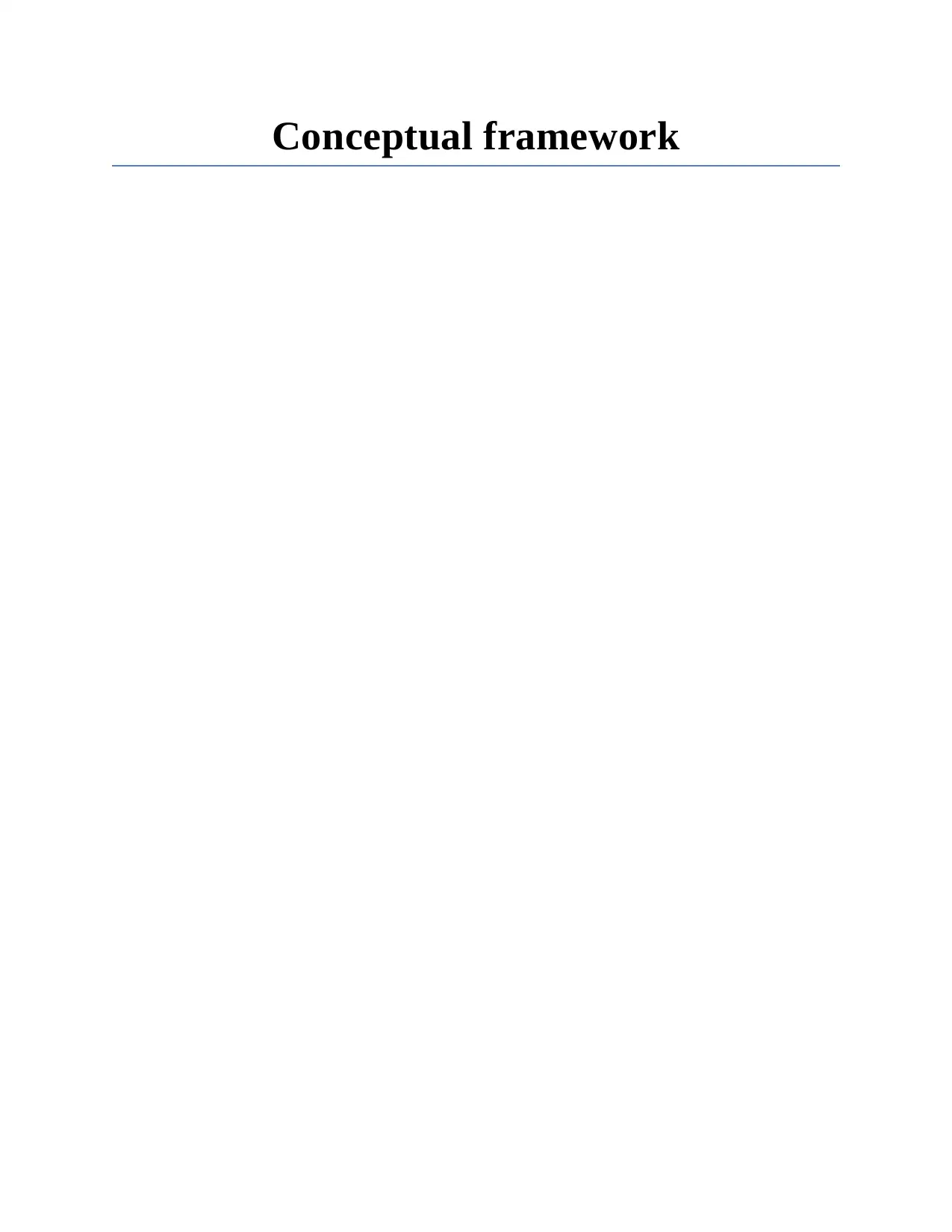
Conceptual framework
Paraphrase This Document
Need a fresh take? Get an instant paraphrase of this document with our AI Paraphraser
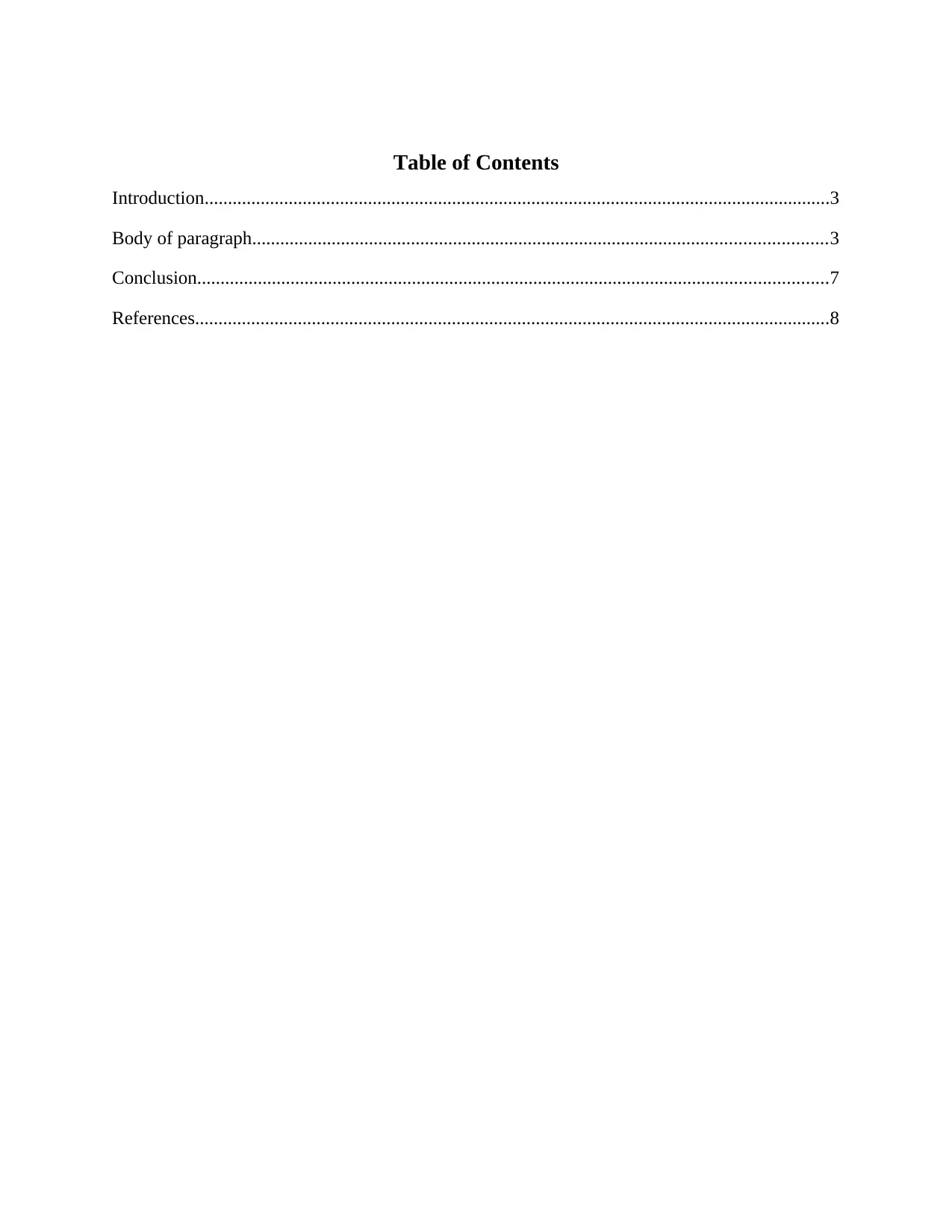
Table of Contents
Introduction......................................................................................................................................3
Body of paragraph...........................................................................................................................3
Conclusion.......................................................................................................................................7
References........................................................................................................................................8
Introduction......................................................................................................................................3
Body of paragraph...........................................................................................................................3
Conclusion.......................................................................................................................................7
References........................................................................................................................................8
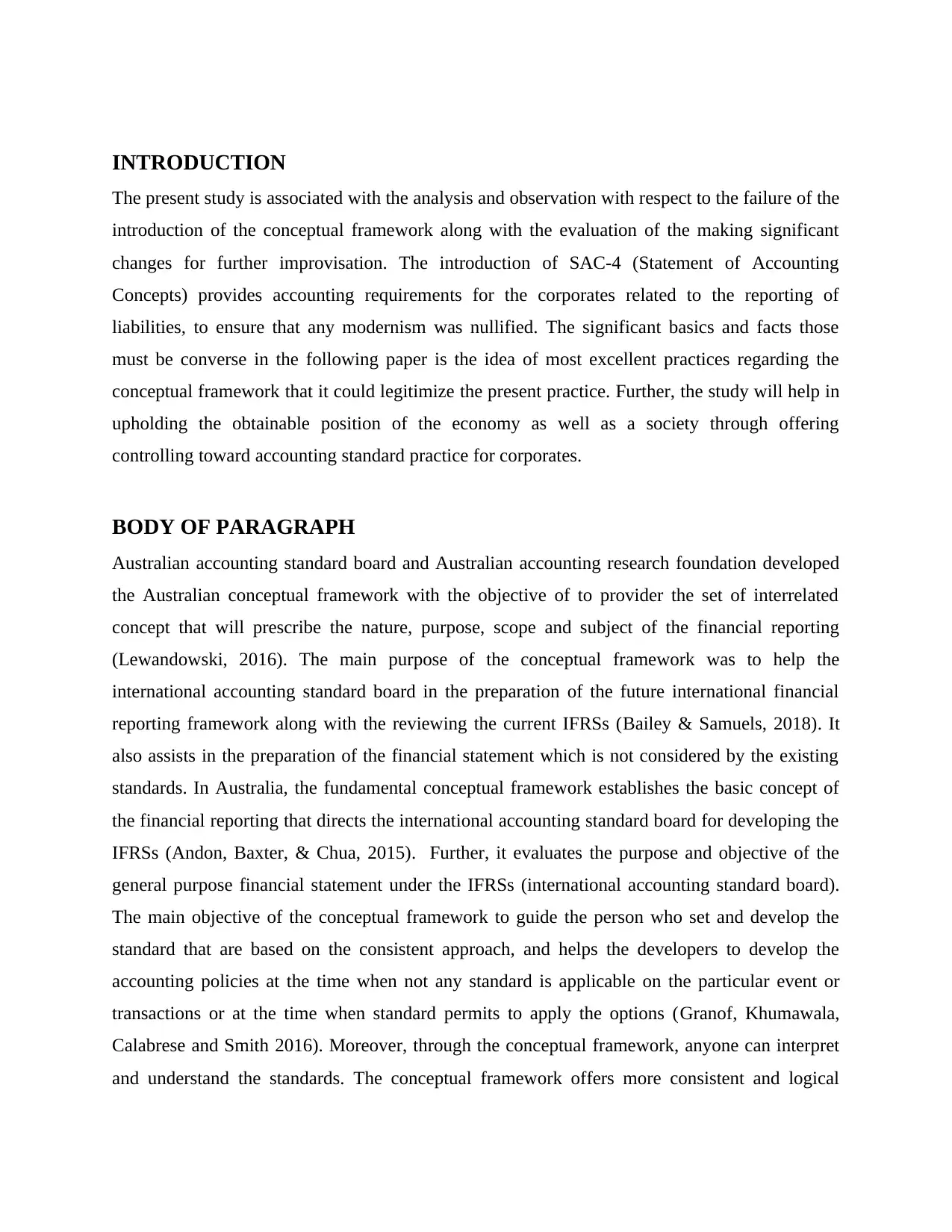
INTRODUCTION
The present study is associated with the analysis and observation with respect to the failure of the
introduction of the conceptual framework along with the evaluation of the making significant
changes for further improvisation. The introduction of SAC-4 (Statement of Accounting
Concepts) provides accounting requirements for the corporates related to the reporting of
liabilities, to ensure that any modernism was nullified. The significant basics and facts those
must be converse in the following paper is the idea of most excellent practices regarding the
conceptual framework that it could legitimize the present practice. Further, the study will help in
upholding the obtainable position of the economy as well as a society through offering
controlling toward accounting standard practice for corporates.
BODY OF PARAGRAPH
Australian accounting standard board and Australian accounting research foundation developed
the Australian conceptual framework with the objective of to provider the set of interrelated
concept that will prescribe the nature, purpose, scope and subject of the financial reporting
(Lewandowski, 2016). The main purpose of the conceptual framework was to help the
international accounting standard board in the preparation of the future international financial
reporting framework along with the reviewing the current IFRSs (Bailey & Samuels, 2018). It
also assists in the preparation of the financial statement which is not considered by the existing
standards. In Australia, the fundamental conceptual framework establishes the basic concept of
the financial reporting that directs the international accounting standard board for developing the
IFRSs (Andon, Baxter, & Chua, 2015). Further, it evaluates the purpose and objective of the
general purpose financial statement under the IFRSs (international accounting standard board).
The main objective of the conceptual framework to guide the person who set and develop the
standard that are based on the consistent approach, and helps the developers to develop the
accounting policies at the time when not any standard is applicable on the particular event or
transactions or at the time when standard permits to apply the options (Granof, Khumawala,
Calabrese and Smith 2016). Moreover, through the conceptual framework, anyone can interpret
and understand the standards. The conceptual framework offers more consistent and logical
The present study is associated with the analysis and observation with respect to the failure of the
introduction of the conceptual framework along with the evaluation of the making significant
changes for further improvisation. The introduction of SAC-4 (Statement of Accounting
Concepts) provides accounting requirements for the corporates related to the reporting of
liabilities, to ensure that any modernism was nullified. The significant basics and facts those
must be converse in the following paper is the idea of most excellent practices regarding the
conceptual framework that it could legitimize the present practice. Further, the study will help in
upholding the obtainable position of the economy as well as a society through offering
controlling toward accounting standard practice for corporates.
BODY OF PARAGRAPH
Australian accounting standard board and Australian accounting research foundation developed
the Australian conceptual framework with the objective of to provider the set of interrelated
concept that will prescribe the nature, purpose, scope and subject of the financial reporting
(Lewandowski, 2016). The main purpose of the conceptual framework was to help the
international accounting standard board in the preparation of the future international financial
reporting framework along with the reviewing the current IFRSs (Bailey & Samuels, 2018). It
also assists in the preparation of the financial statement which is not considered by the existing
standards. In Australia, the fundamental conceptual framework establishes the basic concept of
the financial reporting that directs the international accounting standard board for developing the
IFRSs (Andon, Baxter, & Chua, 2015). Further, it evaluates the purpose and objective of the
general purpose financial statement under the IFRSs (international accounting standard board).
The main objective of the conceptual framework to guide the person who set and develop the
standard that are based on the consistent approach, and helps the developers to develop the
accounting policies at the time when not any standard is applicable on the particular event or
transactions or at the time when standard permits to apply the options (Granof, Khumawala,
Calabrese and Smith 2016). Moreover, through the conceptual framework, anyone can interpret
and understand the standards. The conceptual framework offers more consistent and logical
⊘ This is a preview!⊘
Do you want full access?
Subscribe today to unlock all pages.

Trusted by 1+ million students worldwide
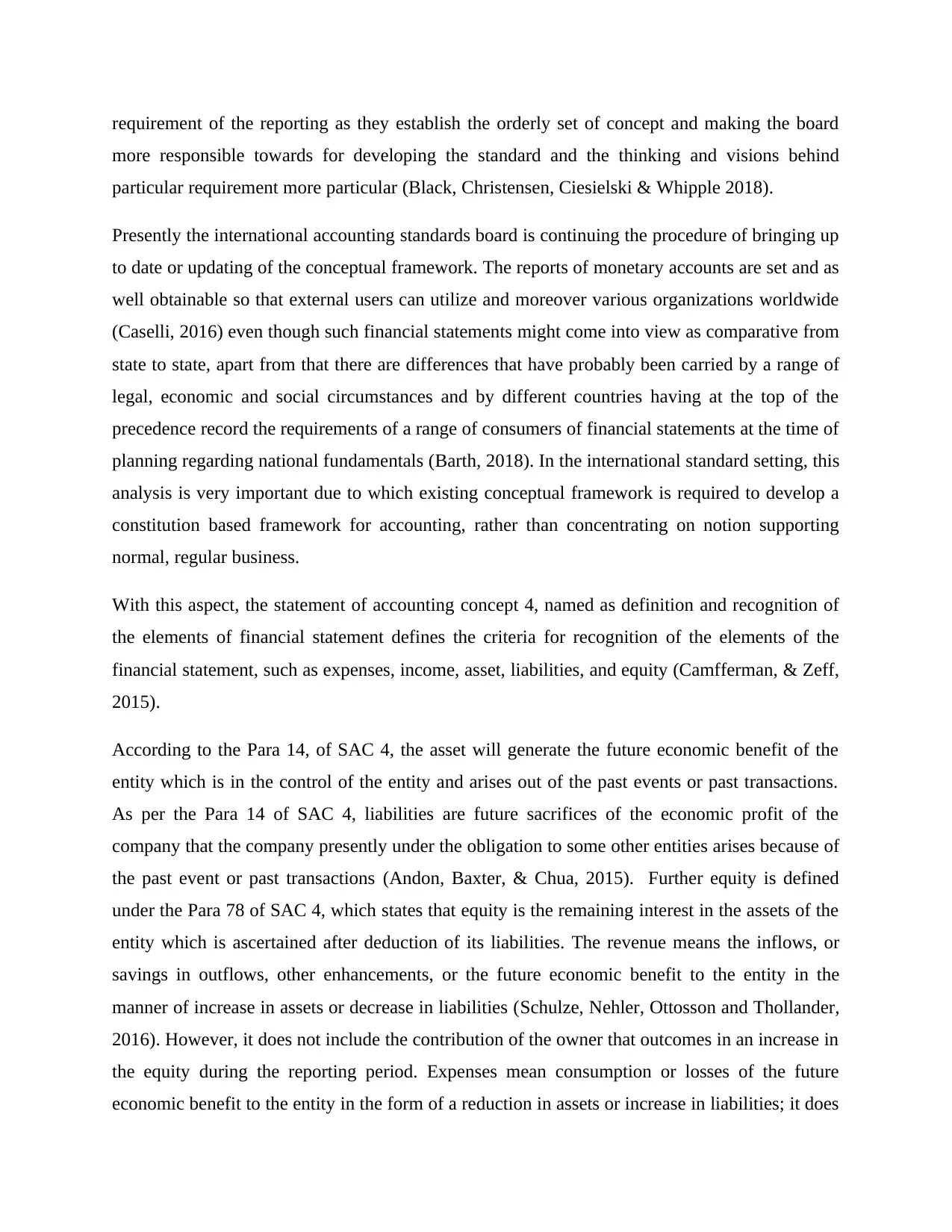
requirement of the reporting as they establish the orderly set of concept and making the board
more responsible towards for developing the standard and the thinking and visions behind
particular requirement more particular (Black, Christensen, Ciesielski & Whipple 2018).
Presently the international accounting standards board is continuing the procedure of bringing up
to date or updating of the conceptual framework. The reports of monetary accounts are set and as
well obtainable so that external users can utilize and moreover various organizations worldwide
(Caselli, 2016) even though such financial statements might come into view as comparative from
state to state, apart from that there are differences that have probably been carried by a range of
legal, economic and social circumstances and by different countries having at the top of the
precedence record the requirements of a range of consumers of financial statements at the time of
planning regarding national fundamentals (Barth, 2018). In the international standard setting, this
analysis is very important due to which existing conceptual framework is required to develop a
constitution based framework for accounting, rather than concentrating on notion supporting
normal, regular business.
With this aspect, the statement of accounting concept 4, named as definition and recognition of
the elements of financial statement defines the criteria for recognition of the elements of the
financial statement, such as expenses, income, asset, liabilities, and equity (Camfferman, & Zeff,
2015).
According to the Para 14, of SAC 4, the asset will generate the future economic benefit of the
entity which is in the control of the entity and arises out of the past events or past transactions.
As per the Para 14 of SAC 4, liabilities are future sacrifices of the economic profit of the
company that the company presently under the obligation to some other entities arises because of
the past event or past transactions (Andon, Baxter, & Chua, 2015). Further equity is defined
under the Para 78 of SAC 4, which states that equity is the remaining interest in the assets of the
entity which is ascertained after deduction of its liabilities. The revenue means the inflows, or
savings in outflows, other enhancements, or the future economic benefit to the entity in the
manner of increase in assets or decrease in liabilities (Schulze, Nehler, Ottosson and Thollander,
2016). However, it does not include the contribution of the owner that outcomes in an increase in
the equity during the reporting period. Expenses mean consumption or losses of the future
economic benefit to the entity in the form of a reduction in assets or increase in liabilities; it does
more responsible towards for developing the standard and the thinking and visions behind
particular requirement more particular (Black, Christensen, Ciesielski & Whipple 2018).
Presently the international accounting standards board is continuing the procedure of bringing up
to date or updating of the conceptual framework. The reports of monetary accounts are set and as
well obtainable so that external users can utilize and moreover various organizations worldwide
(Caselli, 2016) even though such financial statements might come into view as comparative from
state to state, apart from that there are differences that have probably been carried by a range of
legal, economic and social circumstances and by different countries having at the top of the
precedence record the requirements of a range of consumers of financial statements at the time of
planning regarding national fundamentals (Barth, 2018). In the international standard setting, this
analysis is very important due to which existing conceptual framework is required to develop a
constitution based framework for accounting, rather than concentrating on notion supporting
normal, regular business.
With this aspect, the statement of accounting concept 4, named as definition and recognition of
the elements of financial statement defines the criteria for recognition of the elements of the
financial statement, such as expenses, income, asset, liabilities, and equity (Camfferman, & Zeff,
2015).
According to the Para 14, of SAC 4, the asset will generate the future economic benefit of the
entity which is in the control of the entity and arises out of the past events or past transactions.
As per the Para 14 of SAC 4, liabilities are future sacrifices of the economic profit of the
company that the company presently under the obligation to some other entities arises because of
the past event or past transactions (Andon, Baxter, & Chua, 2015). Further equity is defined
under the Para 78 of SAC 4, which states that equity is the remaining interest in the assets of the
entity which is ascertained after deduction of its liabilities. The revenue means the inflows, or
savings in outflows, other enhancements, or the future economic benefit to the entity in the
manner of increase in assets or decrease in liabilities (Schulze, Nehler, Ottosson and Thollander,
2016). However, it does not include the contribution of the owner that outcomes in an increase in
the equity during the reporting period. Expenses mean consumption or losses of the future
economic benefit to the entity in the form of a reduction in assets or increase in liabilities; it does
Paraphrase This Document
Need a fresh take? Get an instant paraphrase of this document with our AI Paraphraser
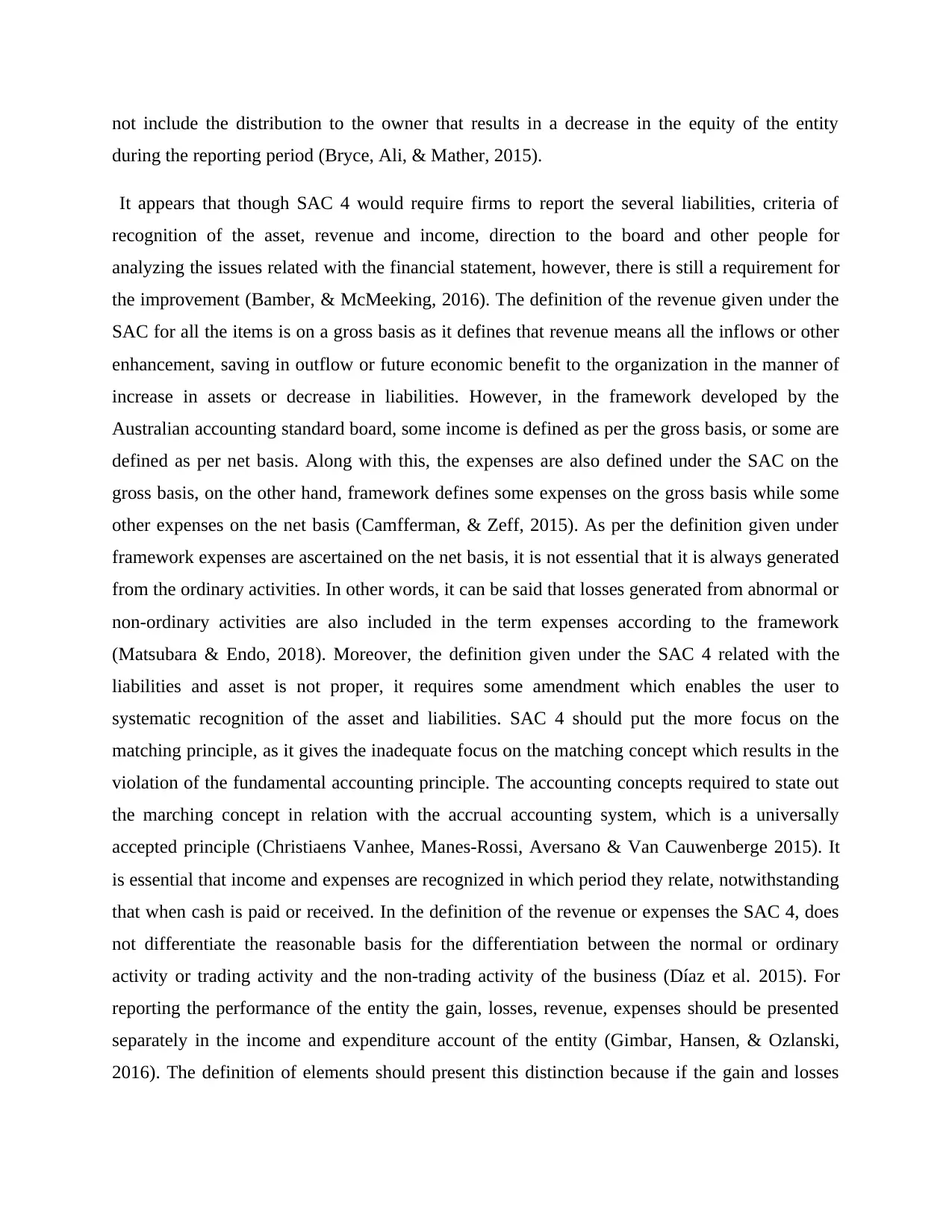
not include the distribution to the owner that results in a decrease in the equity of the entity
during the reporting period (Bryce, Ali, & Mather, 2015).
It appears that though SAC 4 would require firms to report the several liabilities, criteria of
recognition of the asset, revenue and income, direction to the board and other people for
analyzing the issues related with the financial statement, however, there is still a requirement for
the improvement (Bamber, & McMeeking, 2016). The definition of the revenue given under the
SAC for all the items is on a gross basis as it defines that revenue means all the inflows or other
enhancement, saving in outflow or future economic benefit to the organization in the manner of
increase in assets or decrease in liabilities. However, in the framework developed by the
Australian accounting standard board, some income is defined as per the gross basis, or some are
defined as per net basis. Along with this, the expenses are also defined under the SAC on the
gross basis, on the other hand, framework defines some expenses on the gross basis while some
other expenses on the net basis (Camfferman, & Zeff, 2015). As per the definition given under
framework expenses are ascertained on the net basis, it is not essential that it is always generated
from the ordinary activities. In other words, it can be said that losses generated from abnormal or
non-ordinary activities are also included in the term expenses according to the framework
(Matsubara & Endo, 2018). Moreover, the definition given under the SAC 4 related with the
liabilities and asset is not proper, it requires some amendment which enables the user to
systematic recognition of the asset and liabilities. SAC 4 should put the more focus on the
matching principle, as it gives the inadequate focus on the matching concept which results in the
violation of the fundamental accounting principle. The accounting concepts required to state out
the marching concept in relation with the accrual accounting system, which is a universally
accepted principle (Christiaens Vanhee, Manes-Rossi, Aversano & Van Cauwenberge 2015). It
is essential that income and expenses are recognized in which period they relate, notwithstanding
that when cash is paid or received. In the definition of the revenue or expenses the SAC 4, does
not differentiate the reasonable basis for the differentiation between the normal or ordinary
activity or trading activity and the non-trading activity of the business (Díaz et al. 2015). For
reporting the performance of the entity the gain, losses, revenue, expenses should be presented
separately in the income and expenditure account of the entity (Gimbar, Hansen, & Ozlanski,
2016). The definition of elements should present this distinction because if the gain and losses
during the reporting period (Bryce, Ali, & Mather, 2015).
It appears that though SAC 4 would require firms to report the several liabilities, criteria of
recognition of the asset, revenue and income, direction to the board and other people for
analyzing the issues related with the financial statement, however, there is still a requirement for
the improvement (Bamber, & McMeeking, 2016). The definition of the revenue given under the
SAC for all the items is on a gross basis as it defines that revenue means all the inflows or other
enhancement, saving in outflow or future economic benefit to the organization in the manner of
increase in assets or decrease in liabilities. However, in the framework developed by the
Australian accounting standard board, some income is defined as per the gross basis, or some are
defined as per net basis. Along with this, the expenses are also defined under the SAC on the
gross basis, on the other hand, framework defines some expenses on the gross basis while some
other expenses on the net basis (Camfferman, & Zeff, 2015). As per the definition given under
framework expenses are ascertained on the net basis, it is not essential that it is always generated
from the ordinary activities. In other words, it can be said that losses generated from abnormal or
non-ordinary activities are also included in the term expenses according to the framework
(Matsubara & Endo, 2018). Moreover, the definition given under the SAC 4 related with the
liabilities and asset is not proper, it requires some amendment which enables the user to
systematic recognition of the asset and liabilities. SAC 4 should put the more focus on the
matching principle, as it gives the inadequate focus on the matching concept which results in the
violation of the fundamental accounting principle. The accounting concepts required to state out
the marching concept in relation with the accrual accounting system, which is a universally
accepted principle (Christiaens Vanhee, Manes-Rossi, Aversano & Van Cauwenberge 2015). It
is essential that income and expenses are recognized in which period they relate, notwithstanding
that when cash is paid or received. In the definition of the revenue or expenses the SAC 4, does
not differentiate the reasonable basis for the differentiation between the normal or ordinary
activity or trading activity and the non-trading activity of the business (Díaz et al. 2015). For
reporting the performance of the entity the gain, losses, revenue, expenses should be presented
separately in the income and expenditure account of the entity (Gimbar, Hansen, & Ozlanski,
2016). The definition of elements should present this distinction because if the gain and losses
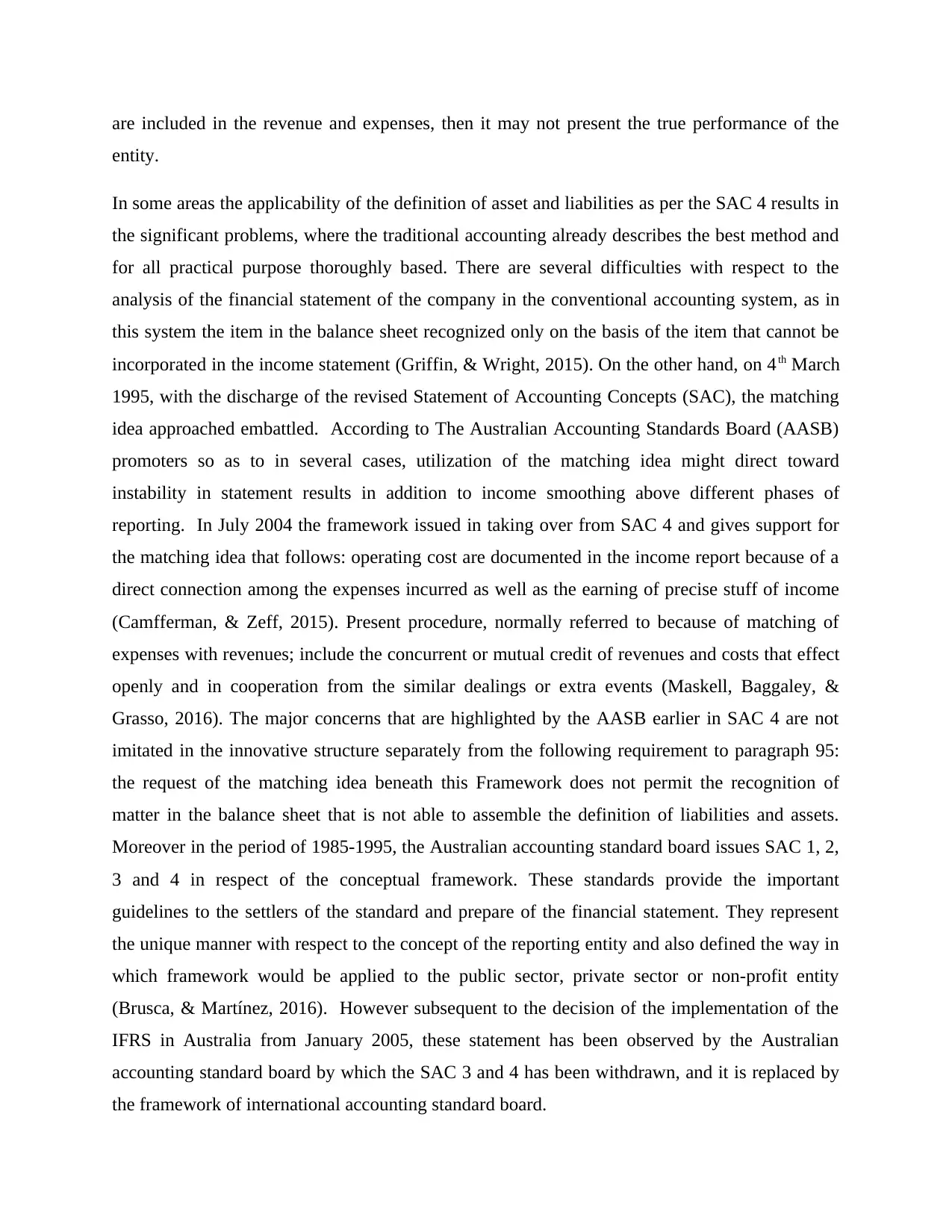
are included in the revenue and expenses, then it may not present the true performance of the
entity.
In some areas the applicability of the definition of asset and liabilities as per the SAC 4 results in
the significant problems, where the traditional accounting already describes the best method and
for all practical purpose thoroughly based. There are several difficulties with respect to the
analysis of the financial statement of the company in the conventional accounting system, as in
this system the item in the balance sheet recognized only on the basis of the item that cannot be
incorporated in the income statement (Griffin, & Wright, 2015). On the other hand, on 4th March
1995, with the discharge of the revised Statement of Accounting Concepts (SAC), the matching
idea approached embattled. According to The Australian Accounting Standards Board (AASB)
promoters so as to in several cases, utilization of the matching idea might direct toward
instability in statement results in addition to income smoothing above different phases of
reporting. In July 2004 the framework issued in taking over from SAC 4 and gives support for
the matching idea that follows: operating cost are documented in the income report because of a
direct connection among the expenses incurred as well as the earning of precise stuff of income
(Camfferman, & Zeff, 2015). Present procedure, normally referred to because of matching of
expenses with revenues; include the concurrent or mutual credit of revenues and costs that effect
openly and in cooperation from the similar dealings or extra events (Maskell, Baggaley, &
Grasso, 2016). The major concerns that are highlighted by the AASB earlier in SAC 4 are not
imitated in the innovative structure separately from the following requirement to paragraph 95:
the request of the matching idea beneath this Framework does not permit the recognition of
matter in the balance sheet that is not able to assemble the definition of liabilities and assets.
Moreover in the period of 1985-1995, the Australian accounting standard board issues SAC 1, 2,
3 and 4 in respect of the conceptual framework. These standards provide the important
guidelines to the settlers of the standard and prepare of the financial statement. They represent
the unique manner with respect to the concept of the reporting entity and also defined the way in
which framework would be applied to the public sector, private sector or non-profit entity
(Brusca, & Martínez, 2016). However subsequent to the decision of the implementation of the
IFRS in Australia from January 2005, these statement has been observed by the Australian
accounting standard board by which the SAC 3 and 4 has been withdrawn, and it is replaced by
the framework of international accounting standard board.
entity.
In some areas the applicability of the definition of asset and liabilities as per the SAC 4 results in
the significant problems, where the traditional accounting already describes the best method and
for all practical purpose thoroughly based. There are several difficulties with respect to the
analysis of the financial statement of the company in the conventional accounting system, as in
this system the item in the balance sheet recognized only on the basis of the item that cannot be
incorporated in the income statement (Griffin, & Wright, 2015). On the other hand, on 4th March
1995, with the discharge of the revised Statement of Accounting Concepts (SAC), the matching
idea approached embattled. According to The Australian Accounting Standards Board (AASB)
promoters so as to in several cases, utilization of the matching idea might direct toward
instability in statement results in addition to income smoothing above different phases of
reporting. In July 2004 the framework issued in taking over from SAC 4 and gives support for
the matching idea that follows: operating cost are documented in the income report because of a
direct connection among the expenses incurred as well as the earning of precise stuff of income
(Camfferman, & Zeff, 2015). Present procedure, normally referred to because of matching of
expenses with revenues; include the concurrent or mutual credit of revenues and costs that effect
openly and in cooperation from the similar dealings or extra events (Maskell, Baggaley, &
Grasso, 2016). The major concerns that are highlighted by the AASB earlier in SAC 4 are not
imitated in the innovative structure separately from the following requirement to paragraph 95:
the request of the matching idea beneath this Framework does not permit the recognition of
matter in the balance sheet that is not able to assemble the definition of liabilities and assets.
Moreover in the period of 1985-1995, the Australian accounting standard board issues SAC 1, 2,
3 and 4 in respect of the conceptual framework. These standards provide the important
guidelines to the settlers of the standard and prepare of the financial statement. They represent
the unique manner with respect to the concept of the reporting entity and also defined the way in
which framework would be applied to the public sector, private sector or non-profit entity
(Brusca, & Martínez, 2016). However subsequent to the decision of the implementation of the
IFRS in Australia from January 2005, these statement has been observed by the Australian
accounting standard board by which the SAC 3 and 4 has been withdrawn, and it is replaced by
the framework of international accounting standard board.
⊘ This is a preview!⊘
Do you want full access?
Subscribe today to unlock all pages.

Trusted by 1+ million students worldwide
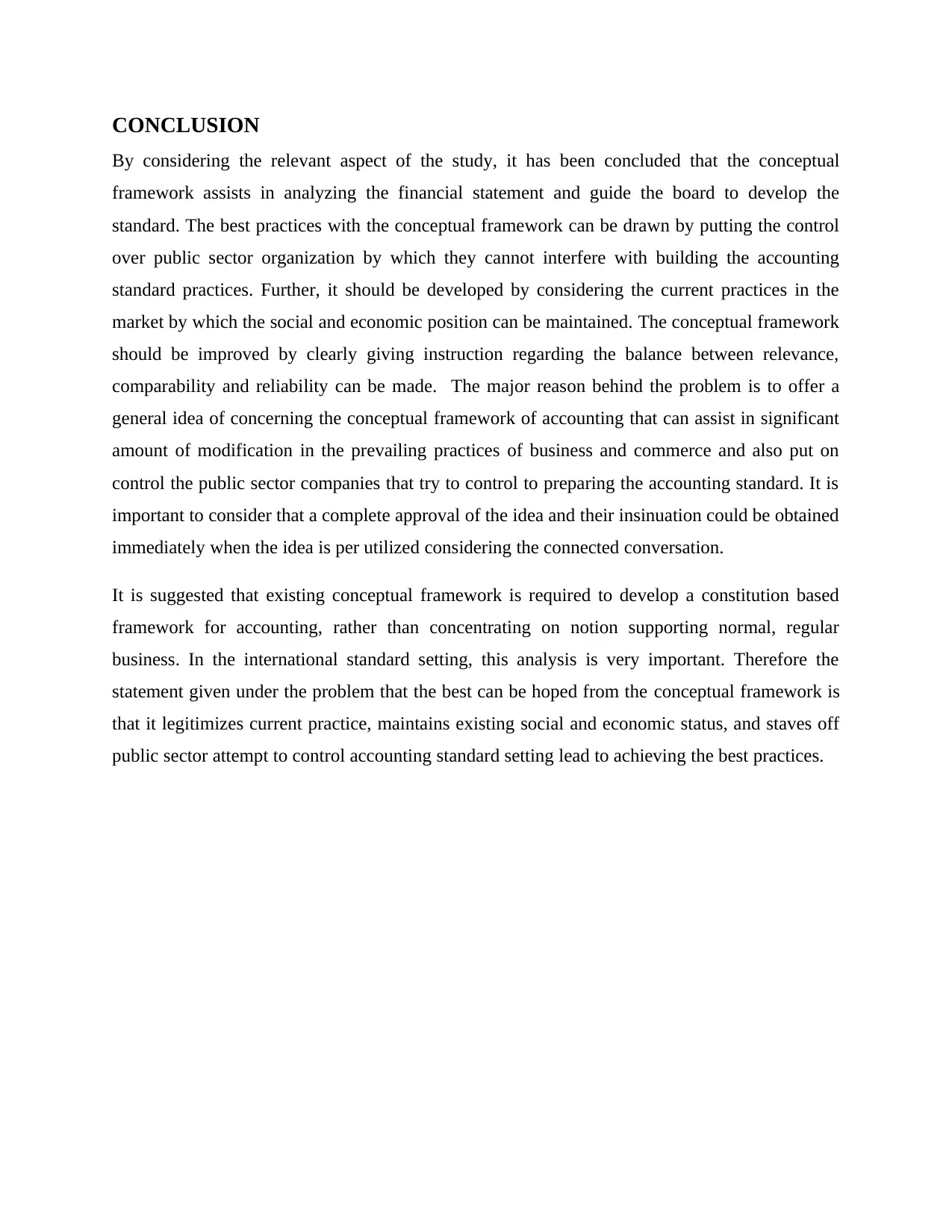
CONCLUSION
By considering the relevant aspect of the study, it has been concluded that the conceptual
framework assists in analyzing the financial statement and guide the board to develop the
standard. The best practices with the conceptual framework can be drawn by putting the control
over public sector organization by which they cannot interfere with building the accounting
standard practices. Further, it should be developed by considering the current practices in the
market by which the social and economic position can be maintained. The conceptual framework
should be improved by clearly giving instruction regarding the balance between relevance,
comparability and reliability can be made. The major reason behind the problem is to offer a
general idea of concerning the conceptual framework of accounting that can assist in significant
amount of modification in the prevailing practices of business and commerce and also put on
control the public sector companies that try to control to preparing the accounting standard. It is
important to consider that a complete approval of the idea and their insinuation could be obtained
immediately when the idea is per utilized considering the connected conversation.
It is suggested that existing conceptual framework is required to develop a constitution based
framework for accounting, rather than concentrating on notion supporting normal, regular
business. In the international standard setting, this analysis is very important. Therefore the
statement given under the problem that the best can be hoped from the conceptual framework is
that it legitimizes current practice, maintains existing social and economic status, and staves off
public sector attempt to control accounting standard setting lead to achieving the best practices.
By considering the relevant aspect of the study, it has been concluded that the conceptual
framework assists in analyzing the financial statement and guide the board to develop the
standard. The best practices with the conceptual framework can be drawn by putting the control
over public sector organization by which they cannot interfere with building the accounting
standard practices. Further, it should be developed by considering the current practices in the
market by which the social and economic position can be maintained. The conceptual framework
should be improved by clearly giving instruction regarding the balance between relevance,
comparability and reliability can be made. The major reason behind the problem is to offer a
general idea of concerning the conceptual framework of accounting that can assist in significant
amount of modification in the prevailing practices of business and commerce and also put on
control the public sector companies that try to control to preparing the accounting standard. It is
important to consider that a complete approval of the idea and their insinuation could be obtained
immediately when the idea is per utilized considering the connected conversation.
It is suggested that existing conceptual framework is required to develop a constitution based
framework for accounting, rather than concentrating on notion supporting normal, regular
business. In the international standard setting, this analysis is very important. Therefore the
statement given under the problem that the best can be hoped from the conceptual framework is
that it legitimizes current practice, maintains existing social and economic status, and staves off
public sector attempt to control accounting standard setting lead to achieving the best practices.
Paraphrase This Document
Need a fresh take? Get an instant paraphrase of this document with our AI Paraphraser
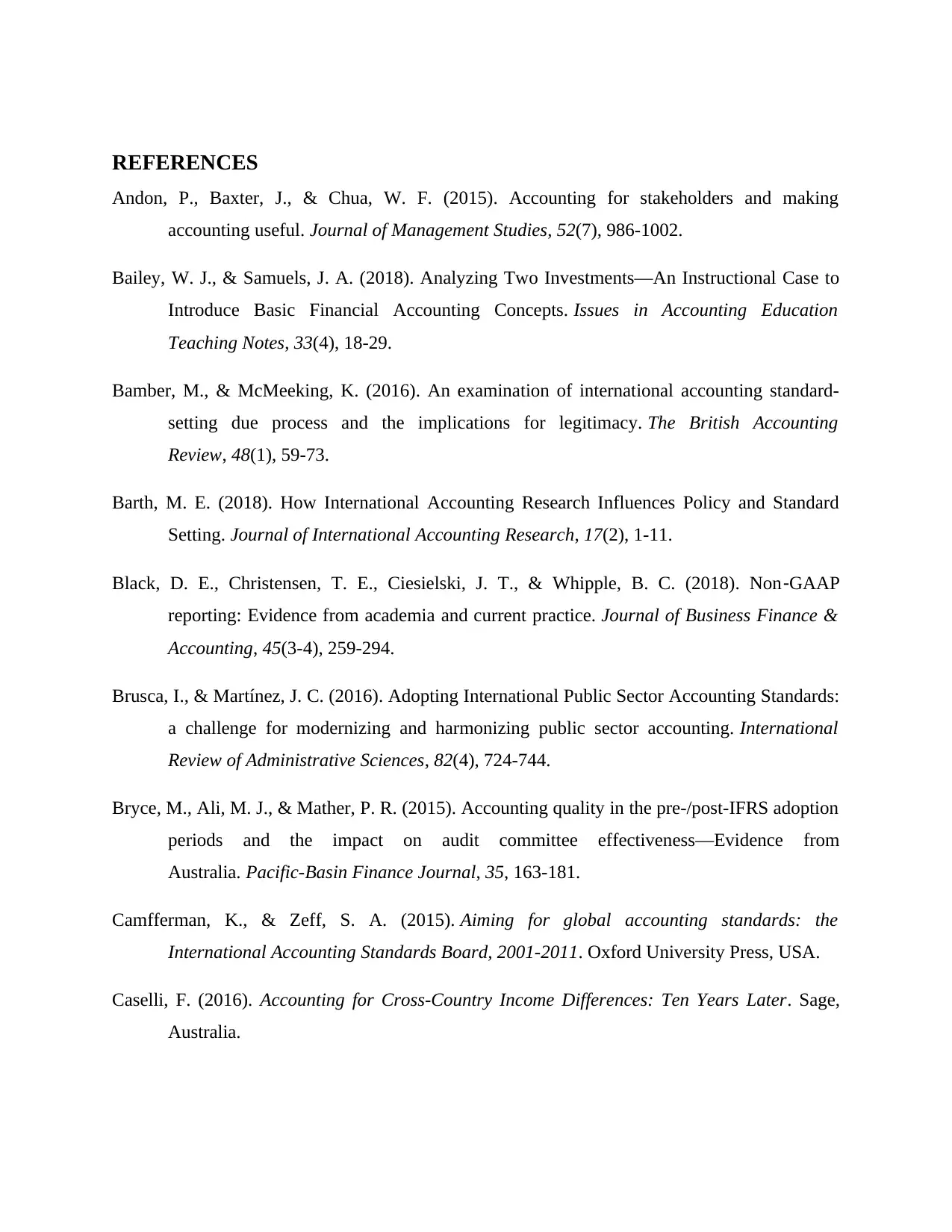
REFERENCES
Andon, P., Baxter, J., & Chua, W. F. (2015). Accounting for stakeholders and making
accounting useful. Journal of Management Studies, 52(7), 986-1002.
Bailey, W. J., & Samuels, J. A. (2018). Analyzing Two Investments—An Instructional Case to
Introduce Basic Financial Accounting Concepts. Issues in Accounting Education
Teaching Notes, 33(4), 18-29.
Bamber, M., & McMeeking, K. (2016). An examination of international accounting standard-
setting due process and the implications for legitimacy. The British Accounting
Review, 48(1), 59-73.
Barth, M. E. (2018). How International Accounting Research Influences Policy and Standard
Setting. Journal of International Accounting Research, 17(2), 1-11.
Black, D. E., Christensen, T. E., Ciesielski, J. T., & Whipple, B. C. (2018). Non‐GAAP
reporting: Evidence from academia and current practice. Journal of Business Finance &
Accounting, 45(3-4), 259-294.
Brusca, I., & Martínez, J. C. (2016). Adopting International Public Sector Accounting Standards:
a challenge for modernizing and harmonizing public sector accounting. International
Review of Administrative Sciences, 82(4), 724-744.
Bryce, M., Ali, M. J., & Mather, P. R. (2015). Accounting quality in the pre-/post-IFRS adoption
periods and the impact on audit committee effectiveness—Evidence from
Australia. Pacific-Basin Finance Journal, 35, 163-181.
Camfferman, K., & Zeff, S. A. (2015). Aiming for global accounting standards: the
International Accounting Standards Board, 2001-2011. Oxford University Press, USA.
Caselli, F. (2016). Accounting for Cross-Country Income Differences: Ten Years Later. Sage,
Australia.
Andon, P., Baxter, J., & Chua, W. F. (2015). Accounting for stakeholders and making
accounting useful. Journal of Management Studies, 52(7), 986-1002.
Bailey, W. J., & Samuels, J. A. (2018). Analyzing Two Investments—An Instructional Case to
Introduce Basic Financial Accounting Concepts. Issues in Accounting Education
Teaching Notes, 33(4), 18-29.
Bamber, M., & McMeeking, K. (2016). An examination of international accounting standard-
setting due process and the implications for legitimacy. The British Accounting
Review, 48(1), 59-73.
Barth, M. E. (2018). How International Accounting Research Influences Policy and Standard
Setting. Journal of International Accounting Research, 17(2), 1-11.
Black, D. E., Christensen, T. E., Ciesielski, J. T., & Whipple, B. C. (2018). Non‐GAAP
reporting: Evidence from academia and current practice. Journal of Business Finance &
Accounting, 45(3-4), 259-294.
Brusca, I., & Martínez, J. C. (2016). Adopting International Public Sector Accounting Standards:
a challenge for modernizing and harmonizing public sector accounting. International
Review of Administrative Sciences, 82(4), 724-744.
Bryce, M., Ali, M. J., & Mather, P. R. (2015). Accounting quality in the pre-/post-IFRS adoption
periods and the impact on audit committee effectiveness—Evidence from
Australia. Pacific-Basin Finance Journal, 35, 163-181.
Camfferman, K., & Zeff, S. A. (2015). Aiming for global accounting standards: the
International Accounting Standards Board, 2001-2011. Oxford University Press, USA.
Caselli, F. (2016). Accounting for Cross-Country Income Differences: Ten Years Later. Sage,
Australia.
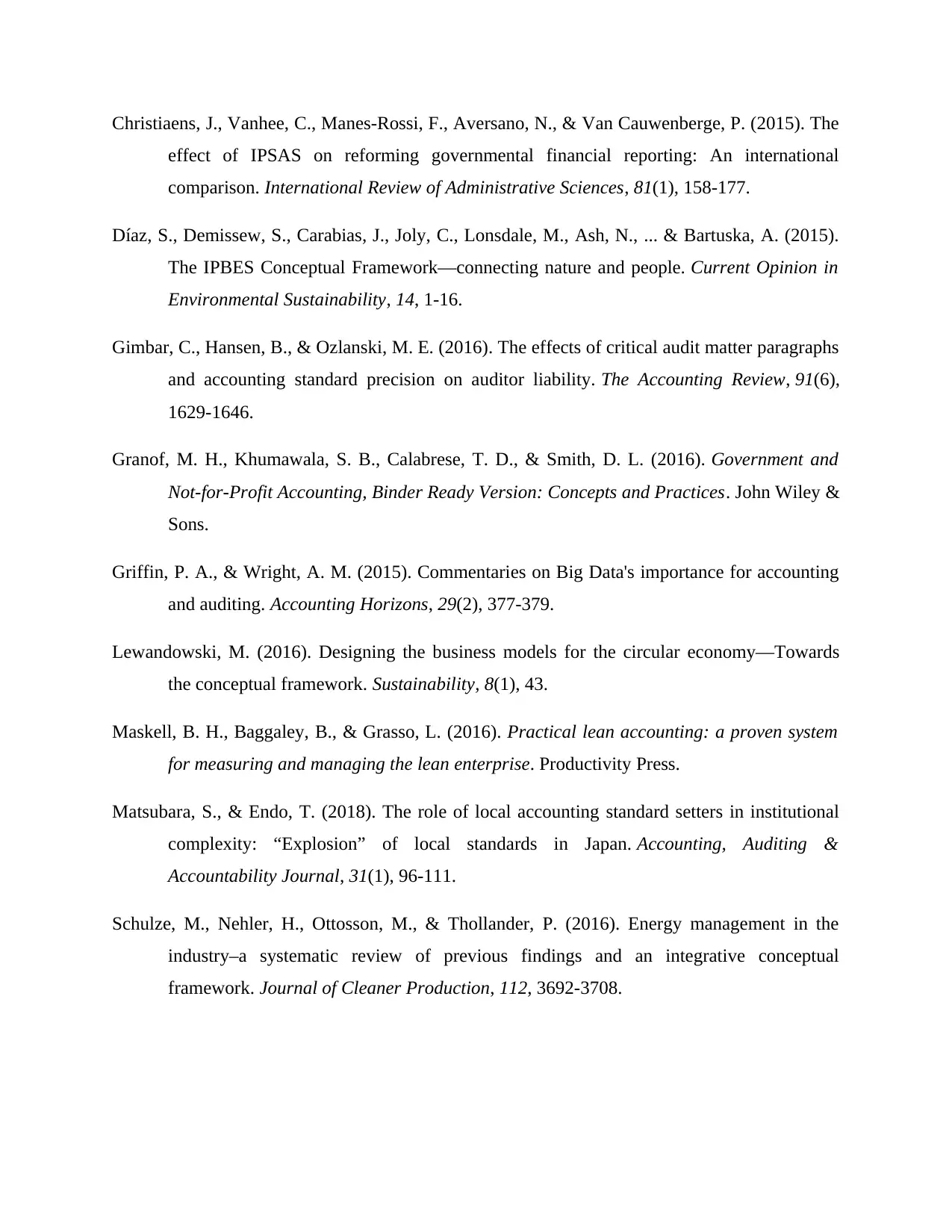
Christiaens, J., Vanhee, C., Manes-Rossi, F., Aversano, N., & Van Cauwenberge, P. (2015). The
effect of IPSAS on reforming governmental financial reporting: An international
comparison. International Review of Administrative Sciences, 81(1), 158-177.
Díaz, S., Demissew, S., Carabias, J., Joly, C., Lonsdale, M., Ash, N., ... & Bartuska, A. (2015).
The IPBES Conceptual Framework—connecting nature and people. Current Opinion in
Environmental Sustainability, 14, 1-16.
Gimbar, C., Hansen, B., & Ozlanski, M. E. (2016). The effects of critical audit matter paragraphs
and accounting standard precision on auditor liability. The Accounting Review, 91(6),
1629-1646.
Granof, M. H., Khumawala, S. B., Calabrese, T. D., & Smith, D. L. (2016). Government and
Not-for-Profit Accounting, Binder Ready Version: Concepts and Practices. John Wiley &
Sons.
Griffin, P. A., & Wright, A. M. (2015). Commentaries on Big Data's importance for accounting
and auditing. Accounting Horizons, 29(2), 377-379.
Lewandowski, M. (2016). Designing the business models for the circular economy—Towards
the conceptual framework. Sustainability, 8(1), 43.
Maskell, B. H., Baggaley, B., & Grasso, L. (2016). Practical lean accounting: a proven system
for measuring and managing the lean enterprise. Productivity Press.
Matsubara, S., & Endo, T. (2018). The role of local accounting standard setters in institutional
complexity: “Explosion” of local standards in Japan. Accounting, Auditing &
Accountability Journal, 31(1), 96-111.
Schulze, M., Nehler, H., Ottosson, M., & Thollander, P. (2016). Energy management in the
industry–a systematic review of previous findings and an integrative conceptual
framework. Journal of Cleaner Production, 112, 3692-3708.
effect of IPSAS on reforming governmental financial reporting: An international
comparison. International Review of Administrative Sciences, 81(1), 158-177.
Díaz, S., Demissew, S., Carabias, J., Joly, C., Lonsdale, M., Ash, N., ... & Bartuska, A. (2015).
The IPBES Conceptual Framework—connecting nature and people. Current Opinion in
Environmental Sustainability, 14, 1-16.
Gimbar, C., Hansen, B., & Ozlanski, M. E. (2016). The effects of critical audit matter paragraphs
and accounting standard precision on auditor liability. The Accounting Review, 91(6),
1629-1646.
Granof, M. H., Khumawala, S. B., Calabrese, T. D., & Smith, D. L. (2016). Government and
Not-for-Profit Accounting, Binder Ready Version: Concepts and Practices. John Wiley &
Sons.
Griffin, P. A., & Wright, A. M. (2015). Commentaries on Big Data's importance for accounting
and auditing. Accounting Horizons, 29(2), 377-379.
Lewandowski, M. (2016). Designing the business models for the circular economy—Towards
the conceptual framework. Sustainability, 8(1), 43.
Maskell, B. H., Baggaley, B., & Grasso, L. (2016). Practical lean accounting: a proven system
for measuring and managing the lean enterprise. Productivity Press.
Matsubara, S., & Endo, T. (2018). The role of local accounting standard setters in institutional
complexity: “Explosion” of local standards in Japan. Accounting, Auditing &
Accountability Journal, 31(1), 96-111.
Schulze, M., Nehler, H., Ottosson, M., & Thollander, P. (2016). Energy management in the
industry–a systematic review of previous findings and an integrative conceptual
framework. Journal of Cleaner Production, 112, 3692-3708.
⊘ This is a preview!⊘
Do you want full access?
Subscribe today to unlock all pages.

Trusted by 1+ million students worldwide
1 out of 9
Related Documents
Your All-in-One AI-Powered Toolkit for Academic Success.
+13062052269
info@desklib.com
Available 24*7 on WhatsApp / Email
![[object Object]](/_next/static/media/star-bottom.7253800d.svg)
Unlock your academic potential
Copyright © 2020–2025 A2Z Services. All Rights Reserved. Developed and managed by ZUCOL.





